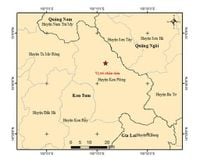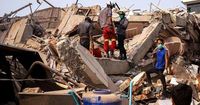Myanmar is grappling with a devastating humanitarian disaster following a catastrophic 7.7 magnitude earthquake that struck on March 28, 2025. This disaster has compounded the struggles of a nation already embroiled in civil strife and conflict, leading to an overwhelming crisis that officials and rescue workers are racing to address.
The earthquake, which was followed by a 6.7 magnitude aftershock just minutes later, has claimed the lives of more than 1,700 individuals in Myanmar, with at least 18 fatalities reported in neighboring Thailand. Rescue operations are underway, with local volunteers and emergency responders working tirelessly to locate survivors among the rubble of collapsed buildings across central Myanmar.
According to reports from the Red Cross, the level of destruction in Myanmar has reached "unprecedented levels not seen in Asia for over a century." The earthquake's impact has devastated numerous structures, including hospitals, and has severely damaged critical infrastructure such as roads and bridges. The disruption has also led to widespread outages of electricity, telephone services, and internet connectivity.
Ko Doe, a rescue worker in Sagaing, expressed the urgency of the situation, stating, "Our team believes there are still around 100 bodies trapped in collapsed buildings. The stench from the bodies we cannot retrieve immediately is overwhelming. We need excavators, cranes, and heavy digging equipment to remove the debris and recover the bodies." This sentiment underscores the dire conditions faced by those involved in the rescue efforts.
In Thailand, emergency services are also engaged in rescue operations at a 30-story building that collapsed in the Chatuchak district of Bangkok, where construction was ongoing. So far, 11 deaths have been confirmed, and 78 individuals remain missing.
The Myanmar military junta has officially reported at least 1,700 deaths, over 3,400 injuries, and a minimum of 300 individuals unaccounted for. However, the true scale of this disaster may take days or even weeks to fully assess, with experts from the U.S. Geological Survey (USGS) estimating that the death toll could exceed 10,000. Economic losses from the earthquake are projected to surpass the country’s annual GDP, indicating a catastrophic impact on Myanmar’s already fragile economy.
On March 30, a minor aftershock caused panic among residents, prompting many to flee hotels in search of safety. These tremors have intensified the ongoing humanitarian crisis in Myanmar, a country that has been embroiled in civil conflict since the military coup in 2021.
In a surprising move, the National Unity Government (NUG), an opposition group fighting against the military regime, declared a partial ceasefire lasting two weeks in the earthquake-affected areas, beginning March 30. This ceasefire aims to facilitate humanitarian efforts and provide relief to those in dire need.
Before the earthquake struck, approximately 15 million people—roughly one-third of Myanmar's population—were already facing severe food insecurity. The ongoing conflict has displaced 3.5 million individuals and pushed the country’s healthcare system to the brink of collapse. A report from the United Nations Office for the Coordination of Humanitarian Affairs (OCHA) highlighted that many hospitals and medical facilities are experiencing acute shortages of medical supplies, further complicating the disaster response.
In the most severely affected areas, residents have reported that they are left to fend for themselves in the aftermath of the earthquake. Han Zin, a local from Sagaing, shared his harrowing experience: "What we see here is widespread destruction—many buildings have completely collapsed. Most of the town has been without power since the disaster, and our drinking water supply is dwindling."
The International Federation of Red Cross and Red Crescent Societies has issued a statement emphasizing the immense devastation and the rapidly increasing humanitarian needs. They warned that with rising temperatures and the rainy season approaching in just a few weeks, there is an urgent need to stabilize affected communities to prevent secondary crises from emerging.
As Myanmar continues to navigate this unprecedented disaster, the international community is urged to provide support and assistance to aid in the recovery efforts. The challenges are monumental, but the resilience of the people and the solidarity among humanitarian organizations may pave the way for a glimmer of hope amidst the chaos.
Meanwhile, in Vietnam, four minor earthquakes were recorded in Kon Tum province, occurring early on March 31, 2025. The first earthquake, with a magnitude of 3.1, struck at 4:08 AM, followed by a 3.0 magnitude quake just minutes later. The subsequent tremors, measuring 2.6 and 2.9, occurred later in the morning. The Institute of Earth Sciences assessed these earthquakes as having a disaster risk level of zero, indicating they are unlikely to cause damage.
Experts believe these seismic events may be linked to the larger earthquake in Myanmar, suggesting that while they are not expected to cause significant harm, they could continue to occur. The local authorities are advised to stay vigilant and prepare for potential aftershocks as the situation develops.
The recent seismic activity in both Myanmar and Vietnam serves as a stark reminder of the unpredictable nature of natural disasters and the importance of preparedness and resilience in the face of such challenges.






